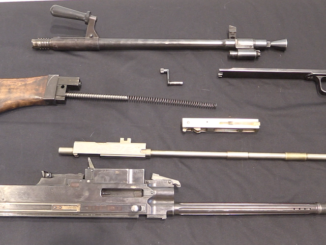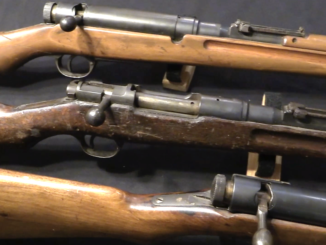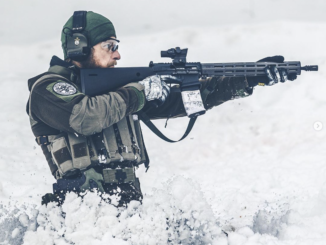During the 1930s, there was interest in Finland in replacing the Maxim heavy machine gun with something handier and more mobile. There were experiments with large drum magazines for the LS-26 light machine gun, but these were not satisfactory. Aimo Lahti began to work on a gas-operated GPMG, but lack of funding and competing priorities led to it having slow progress until the eve of the Winter War. By the time the gun was completed and the first preproduction batch ready for troop trials, the Continuation War was underway.
Twenty eight of the L41 Sampo machine guns were sent out to a variety of units for field testing in the fall of 1942, and the guns were generally well liked, although not perfect. Before improvements and full-scale production could begin, though, the Finnish military was basically distracted by an alternative possibility of procuring MG42 receivers from Germany and building them into complete guns in 7.62x54R. At least one such prototype was completed, and that project caused the L41 program to stall. By the time it might have progressed, the war was going rather badly for Germany and the possibility of getting receivers was basically gone. The L41 never did see further refinement or production, although the trials guns remained in service with their units, in a few cases right until the end of the war.
Mechanically, the L41 is a fascinating hybrid of Bren/ZB and Maxim elements, and incredibly sturdily built. Only seven are know to survive today, six in Finland and this one in the UK. Thanks to the British Royal Armouries for giving me access to it to film for you!




“(…)Sampo”
If anybody is wondering about that name: it was mythical item in Finnish folklore providing power and riches https://www.ancient-origins.net/myths-legends-europe/magical-sampo-object-power-and-riches-finnish-folklore-002891
poor sampo, it wasn’t adopted as a magazine fed lmg, and not as a belt fed gpmg.
Interesting design. I wonder what drove the requirement for a second rifle-type side extractor after a half century of reliable T-slot experience in this type of feed system.
I think you mean the Maxim type, not sure; but think so, sooo… Why do you think Mike? Out of intetest.
Pdb,
Right, the Maxim / Vickers, and also the BMGs (same pull-swipe-push feed concept). Neither is without areas for improvement (as Ian noted), but I’ve never heard feed reliability cited as one of them. I honestly can’t think of why they thought it was necessary, at least not without actually handling the bolt myself.
.50 Brownings, think that is why I remembered that; if they do it… Interesting point, be good to find out why this gun doesn’t. I will have to look back at the other guns that do, do it; as I have forgot why they do… Then look at this again, he he.
I quite like that “Caveat” if it was slimmed down, thinking rebated rim… Oddly enough.
Hmm… Heavy internals, maybe… Definately to do with API, my thoughts, new lightweight svelte outer; angle off the gas block to a side… Anyhoo, he he.
What a huge gun, everything is so big the feed tray thing… Etc; Maybe a design thing; working on it like, before computers etc… Big model, working model… Model, it is just so big; must be that I.e. Oversized on purpose, prototype etc. 30’s = Lot of drawing, no cut and paste, etc. API job firing pin, actuated by the the locking block moving into battery (Up) releases the now spring loaded firing pin… Angled surfaces, on the pin/in the locking block actuate; pin forward/back. So fires, just prior to locking, recocks upon locking block going down… Api no gas system, just weight like; using similar dimensions/mass of what was the piston etc, holding spring. Looking at bolt, still strikes me as rebated rim/api thing… Needs more work, clearly.
Point? Bullpub, Fg42 it… Pistol grip under feed tray, .338 norma (But rebated rim” Ongoing. Think it is the double bolt thing, making me think Api chunky like.
Rw52 side lever type cocking “Pellet gun” good spring/leverage. So a fair (tall) but short, and not especially fat gun… Still liking it.
“Rw52(…)”
What is this?
Heavy spring, and cut \ onto rear of locking bit; unlock via pressure on bolt, spring pressure on carrier “Remember it fired before bolt fully forward” so wants to unlock asap, locking piece must go down, and in this case move carrier back slightly against spring. Benefits; cheaper to make in theory.
Spring cocking system Rws 54 actually, meh been along time. Side lever, good spring cocking angle, thing.
No, still standing by it; due to premise of it being that much more cheap to make we could give on to every Conchita of many in the future forces and just say fire it that way without looking with your toes. At one point, some round will hit a Russian. I am not especially keen on shooting Russians just saying if we keep winding them up we might have to as they’ll get all beligerent.
Modify carrier to be actuated upon angled locking piece being pushed down on frame; simple angling, of it against carrier (Must work vice versa; and it has to cock fire/spring of firing pin.) Fag packet, back of drawing needed. Quite simple; big spring and weight = carrier, actuated by locking piece. Movement of. Can’t be far off, burp. Point, short, slim’ish cheap gmpg; knock them out, give everyone one for every tranny we’ll have a rambo with a belt of bullets wrapped around them and a sweatband on.
If you are Russian I appogise but the modern world is changing; you know how you like Def Leopard still… Times change.
The tall bit is not an issue, the shoulder stock wants to be tall. Inline.
“(…)drawing, no cut and paste(…)”
Are you aware that pantograph https://en.wikipedia.org/wiki/Pantograph was already known in 1930s?
Good job, bet it still took awhile mind; well why do you think this gun was so big, Mr Magoo designed or what…
Do we have any info on the MG 42 using 7.62×54? Doesn’t the 7.92 version use a push through belt? I am curious as to how they modified the design to work with rimmed cartridges.
The Collector’s Grade book on the MG34/42 by Folke Myrvang has a couple of pages on the things and some illustrations of the links. Aimo Lahti’s brother Aarno basically redesigned the German belt to be a two-prong affair that looks a lot like the PK/PKM family’s tuning-fork cartridge belt extractor, and it feeds forward. Supposedly, the Finns got that to work pretty well, but as Ian says, the implementation tripped over the Germans starting to lose the war and cutting them off from MG42 receivers. Interestingly, the Finns also felt that the Lafette tripod sucked, so they modified a Russian one to put under their guns, using the Lafette cradle.
The cite for that is “MG34-MG42 German Universal Machineguns” by Folke Myrvang, pp.187-189.
“(…)any info on the MG 42 using 7.62×54?(…)”
Yes, see 7.62 mm general purpose machinegun MG 42: chapter in http://www.jaegerplatoon.net/ALMOST1.htm
“(…)modified the design to work with rimmed cartridges.(…)”
Aimo Lahti succeeded to making this by designing a new feeding mechanism, modified bolt and his brother Aarno Lahti developed new kind of ammunition belt made from steel for 7.62 x 54R caliber MG 42. The ammunition belt that the designed was unusual as it allowed rimmed ammunition to be fed forward though its belt loops.
Note that this make it akin to later Czechoslovak UK Vz.59 http://modernfirearms.net/en/machineguns/czech-republic-machineguns/vz-59-uk-vz-59-eng/ in regard of belt used.
Currently one MG 42 prototype in 7.62 mm x 54R calibre(…)belongs to collections of Finnish Military Museum. so you should probably nab them if you wish to know more.
Excellent video with the camera slowly and well focussed filming the parts of the mg in the beginning of the video. The rest, as per usual, was also top notch.
Kirk, there has been a new research article attempting to compare the military capabilities of the Bren against the MG42 published by Fisher of Vickers MG research.
Given your strong stances on machine guns, it would be fascinating to read your comments on this paper.
https://www.tandfonline.com/doi/full/10.1080/03071847.2024.2347298
@Green,
Firstly, I’m grateful for you pointing that out to us. It’s a valuable resource, if only for the citations in it…
That said, my impression of it could be summed up along the lines of what Henry Ford said of his accountants: “They know the price of everything, and the value of nothing…”
Overall, the paper is an outstanding bit of scholarship. Scholarship. Not much else. It’s not even really very good scholarship, because while they’ve gone into depth on a bunch of things, they’ve utterly failed to go to original source material, particularly on the German side of things. As I’ve often pointed out before, that’s mostly because nobody has really bothered to dig into all the theoretical work and analysis done by the Germans, and there’s damned little equivalent on the Allied side that’s of equivalent detail or depth. The French may have done something, but I’m unaware of it. The UK and the US definitely did not, unless there’s a trove of stuff out there that I’ve not ever seen.
You can also find a bunch of the wartime “sour grapes” repeated in that paper, wherein they’re still trying to convince the troops that the German MG systems weren’t anywhere near as bad as they were experiencing. You can bullshit a lot of people a lot of the time, but the casualties generated are hard to refute or bullshit your way around. The BREN was an excellent LMG; what it was not was a GPMG that could deliver the sort of sustained fire that you could get from an MG34/42 system, even when operating in the LMG role. Belts vs. box means that there’s always an inherent difference in rates of fire potential, and “accuracy” doesn’t really mean much when you have to cease fire to reload in the middle of delivering opportunity fires on rapidly appearing and disappearing targets out at range. That crap adds up, and is one reason that a box magazine weapon is inferior to a belt-fed one.
Basically, while it’s a decent bit of scholarship, the paper suffers from a major flaw: Nobody writing it has apparently ever been on an MG team, or controlled fires of an MG team. If they had included actual practitioners and users in their contributors to the paper, I think they’d have reached several different conclusions with their numbers.
End of the day? You give me a belt-fed MG vs. a box magazine-fed one, and I’m going to kill far more of you than you are of me. It’s the little things, like not having to change magazines in the middle of a burst that’s engaging a moving squad-size element at range, and being able to deliver volumes of fire that a magazine-fed weapon can only day-dream of. The Germans experimented with everything they could think of, including box-magazine feed in the MG13 and MG30 weapons. Other than limited use in aviation, they opted for belt-fed after considerable development work. They had their reasons; same as with the “too-high rate-of-fire” that everyone so despises in the MG34/42 family. It’s a fact that the successor to the MG42 was supposed to have an even higher rate-of-fire, minimum of 1500rpm, and that those choices were made with malice aforethought and great deliberation. The Germans simply had a different outlook on the machinegun than the allies; their mentality is clearly laid out by the fact highlighted in this very paper, in that the BREN was run by a separate, lower-ranking NCO, and the MG34/42 was directly under the squad leader… The Allies basically used the machinegun to support their riflemen, while the Germans used their riflemen to support the MG team and its effects.
Which worked better? Once you account for and subtract all the Allied support weapons, and leave it down to small arms alone? The tale of the casualties on all fronts wherever the Allies weren’t able to bring their accessory supporting arms to bear. The number of dead Allied soldiers who might have lived had we had better, more effective doctrine? Unknowable, but the exchange ratios show that we could have done a lot better than we did.